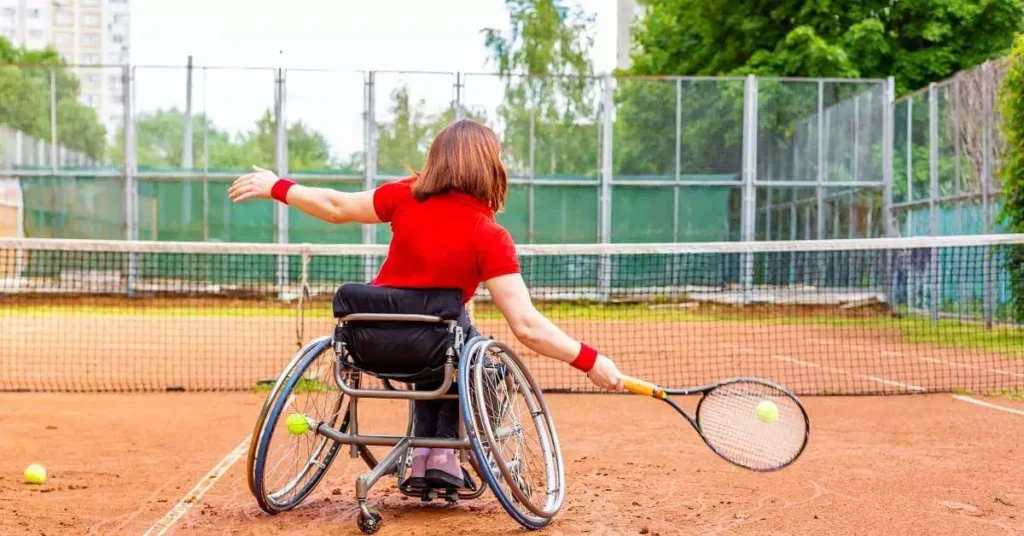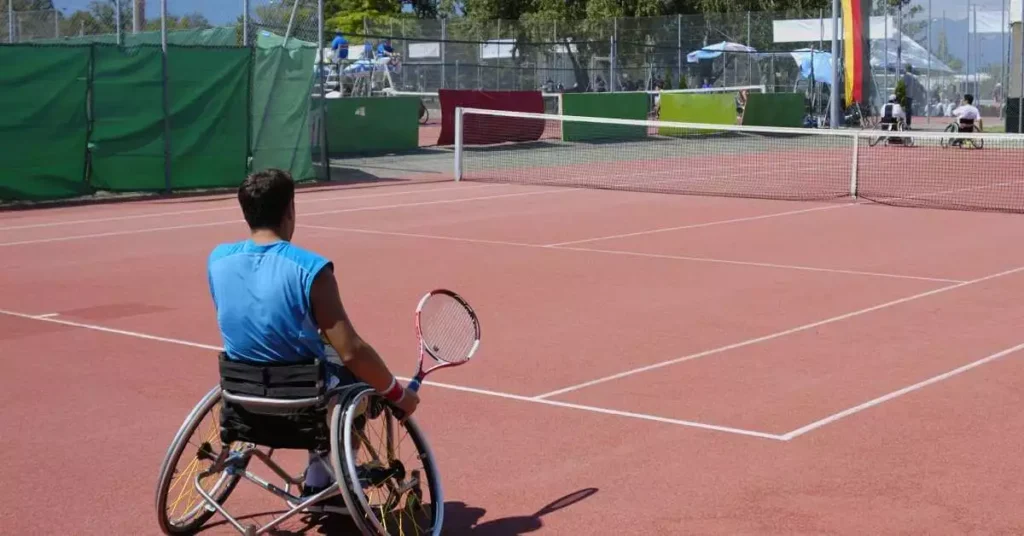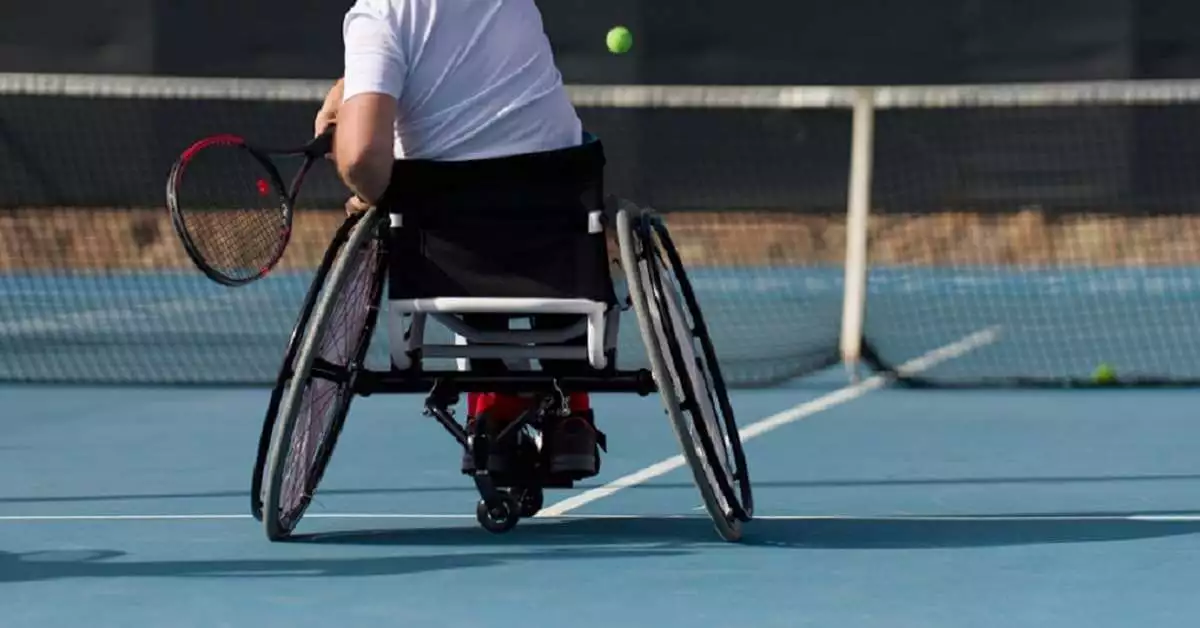Wheelchair tennis is a sport that has been gaining in popularity in recent years, as more and more athletes with disabilities are discovering the thrill of competition on the court. Whether you’re a seasoned tennis player or a newcomer to the game, there’s no denying the incredible skill and athleticism required to excel at wheelchair tennis.
We’ll be taking a deep dive into the world of wheelchair tennis, exploring the rules and regulations of the game, as well as the inspiring stories of some of the sport’s most talented and dedicated athletes. From the challenges of adapting to a new style of play to the incredible sense of accomplishment that comes with winning a match, we’ll be exploring all the highs and lows of this incredible sport.
So whether you’re a fan of tennis or just looking for a new sport to try, be sure to read on and discover the amazing world of wheelchair tennis.
History and Evolution
Wheelchair tennis has come a long way since its inception in the mid-1970s. Today, it is a popular sport played by athletes with a range of disabilities. In this section, you will learn about the history and evolution of wheelchair tennis, including its origin and growth.
Brad Parks and the Origin
In 1976, Brad Parks, a young man from California, became paralyzed after a freestyle skiing accident. During his rehabilitation, Parks discovered that he missed playing tennis. He and a fellow rehab patient, Jeff Minnebraker, decided to give tennis in a wheelchair a try across the street from the hospital at some local tennis courts. This was the beginning of wheelchair tennis.
Parks soon realized that he was not alone in his desire to play tennis. He began organizing tournaments for wheelchair athletes, and in 1978, the first national wheelchair tennis championship was held in California. Parks continued to work tirelessly to promote the sport, and in 1988, wheelchair tennis was featured as a demonstration event at the Paralympic Games in Seoul, South Korea.
Growth and Global Expansion

The sport of wheelchair tennis grew throughout the 1970s and 1980s, first in the United States and then to the rest of the world. In 1982, France became the first country in Europe to put a wheelchair tennis program in place. Since then, much effort has been made to promote the sport at the elite-level.
Today, wheelchair tennis is played in more than 100 countries, and there are numerous international tournaments held each year. The International Tennis Federation (ITF) oversees the sport at the international level, and the ITF Wheelchair Tennis Tour began in 1992 with eleven international tournaments.
The growth of wheelchair tennis can be attributed to the efforts of many individuals and organizations, including Brad Parks and the National Spinal Injuries Centre at Stoke Mandeville Hospital in England. These pioneers recognized the potential of wheelchair tennis as a means of promoting physical activity and social inclusion for people with disabilities.
Rules and Gameplay
Wheelchair tennis is played on a standard tennis court with a few modifications to accommodate the wheelchair players. The rules of wheelchair tennis are the same as those of stand-up tennis, with a few exceptions.
Court and Equipment
The court dimensions are the same as those of a standard tennis court. The net height is the same as in stand-up tennis. The only difference in equipment is that the players use specially designed wheelchairs that have cambered wheels to prevent tipping and allow for quick turns.
Scoring and Bounces
The scoring system in wheelchair tennis is the same as in stand-up tennis. However, there is a Two Bounce Rule that is unique to wheelchair tennis. Wheelchair tennis players are allowed two bounces of the ball. Players must return the ball before it bounces a third time. The second bounce can be either in or out of the court boundaries.
The Ball Bounce Rule significantly influences the pace and rhythm of wheelchair tennis matches. Players must not only anticipate the ball’s trajectory but also adjust their positioning and shot selection accordingly. The first bounce is usually the most critical and sets up the rest of the point.
Players must use a racket to hit the ball and must not touch the net or cross the center line during play. If a player violates any of these rules, they lose the point.
Tournaments and Competitions
Wheelchair tennis has a vibrant tournament scene that offers players of all skill levels the opportunity to compete against each other. Here are some of the most prestigious tournaments and competitions in wheelchair tennis:
Grand Slams
The four Grand Slams – Australian Open, Roland Garros, Wimbledon, and the US Open – are the most prestigious tournaments in tennis, and wheelchair tennis is no exception. The wheelchair events at the Grand Slams offer players the chance to compete for a Grand Slam title and earn valuable ranking points.
Paralympics
Wheelchair tennis is a medal sport at the Paralympic Games, which are held every four years. The Paralympics are the pinnacle of wheelchair tennis competition, and winning a medal is the ultimate goal for many players.
ITF Wheelchair Tennis Tour
The International Tennis Federation (ITF) Wheelchair Tennis Tour is the premier wheelchair tennis tour in the world. The tour features tournaments at various levels, from ITF 1 Series events to ITF Futures events. Players earn ranking points based on their results at these tournaments, and the top players qualify for the end-of-year Wheelchair Tennis Masters.
BNP Paribas World Team Cup
The BNP Paribas World Team Cup is the wheelchair tennis equivalent of the Davis Cup and Fed Cup. National teams compete against each other in a team format, with the winners being crowned world champions.
Uniqlo Wheelchair Doubles Masters
The Uniqlo Wheelchair Doubles Masters is the end-of-year doubles championship for wheelchair tennis. The top eight doubles teams in the world qualify for the event, which is held in conjunction with the Wheelchair Tennis Masters.
Notable Players and Achievements

Wheelchair tennis has seen some incredible players over the years, breaking barriers and achieving unprecedented success. Here are some of the notable players and their achievements:
Men’s Category
In the men’s category, one of the most successful players is Shingo Kunieda from Japan. He has won 24 Grand Slam singles titles and 23 Grand Slam doubles titles, making him one of the most successful wheelchair tennis players of all time. Another notable player is Gustavo Fernandez from Argentina, who has won 9 Grand Slam singles titles and 7 Grand Slam doubles titles.
Women’s Category
Esther Vergeer from the Netherlands is one of the most successful wheelchair tennis players of all time, having won an incredible 42 Grand Slam singles titles and 23 Grand Slam doubles titles. She retired in 2013 with an unbeaten run of 470 matches and seven Paralympic gold medals. Another notable player is Diede de Groot from the Netherlands, who has won 12 Grand Slam singles titles and 13 Grand Slam doubles titles.
Quads Category
In the quads category, David Wagner from the United States is one of the most successful players, having won 7 Grand Slam singles titles and 16 Grand Slam doubles titles. He also won three Paralympic gold medals. Another notable quad player is Dylan Alcott from Australia, who has won 14 Grand Slam singles titles and 13 Grand Slam doubles titles.
Equipment and Adaptations
Wheelchair tennis is a sport that requires minimal adaptations to the traditional tennis equipment. The only specialist equipment required is a tennis wheelchair. These chairs are designed to provide better balance and mobility, and have wheels that slant out to help you turn quicker.
Players can use their own tennis wheelchair or borrow one from the tournament organizers. The International Tennis Federation (ITF) has specific guidelines for the design and dimensions of tennis wheelchairs to ensure fair play. For example, the maximum height of the chair from the ground is 50 cm, and the maximum width is 70 cm.
In addition to a tennis wheelchair, players also use a tennis racquet and ball. No modifications are necessary for the racket and the ball. Players may choose to use a grip aid, such as a wristband or a glove, to help them hold the racket more securely.
It is important to note that players must remain seated in their wheelchair at all times during play, and may not use their feet to propel themselves or their chair. The only exception is when the player needs to adjust their position or fix their chair.
Marketing and Sponsorship
Marketing and sponsorship are crucial aspects of any sport, including wheelchair tennis. The promotion of wheelchair tennis players and events can help increase awareness, attract new fans, and generate revenue. In this section, we will explore some of the key players and initiatives in the marketing and sponsorship of wheelchair tennis.
NEC and UNIQLO
NEC and UNIQLO are two major sponsors of wheelchair tennis. NEC has been the title sponsor of the NEC Wheelchair Singles Masters for over 30 years, and it has also been an international sponsor of several UNIQLO Wheelchair Tennis Tour events. In 2017, NEC renewed its sponsorship agreement for an additional three years, until 2020. In 2021, the company extended its sponsorship until 2023. UNIQLO, on the other hand, has been the official apparel sponsor of the Wheelchair Tennis Tour since 2014. The company has also sponsored the UNIQLO Wheelchair Doubles Masters since 2015.
Marketing Initiatives
Marketing initiatives for wheelchair tennis have been developed in various countries and regions. In Barcelona, for example, the International Tennis Federation (ITF) and the Catalan Tennis Federation launched the “Tennis in a Wheelchair” program in 2019.
The program aims to promote wheelchair tennis and provide opportunities for people with disabilities to participate in the sport. In Japan, the Japan Wheelchair Tennis Association has been promoting the sport through various initiatives, including the “Tennis for All” program, which provides opportunities for people with disabilities to learn and play tennis. In Europe, the ITF has been working with national associations to develop wheelchair tennis programs and events.
In the Netherlands, for example, the Dutch Tennis Federation has been organizing the ABN AMRO World Wheelchair Tennis Tournament since 2009, which has become one of the most prestigious wheelchair tennis events in the world.
Jeff Minnebraker
Jeff Minnebraker is a former wheelchair tennis player who has become a prominent figure in the promotion of the sport. He is the founder of the Wheelchair Tennis Players Association (WTPA), which aims to promote the sport and improve the conditions for wheelchair tennis players. Minnebraker has also been involved in the development of the UNIQLO Wheelchair Doubles Masters, which he helped to create in 2015. He has been a vocal advocate for the promotion of wheelchair tennis and the recognition of its athletes.
Impact and Influence

Wheelchair tennis has had a significant impact on both the para sport community and the able-bodied game. It has brought a new level of athleticism and competition to the sport of tennis, and has helped to break down barriers and stereotypes associated with physical disability.
One of the most significant impacts of wheelchair tennis has been the increased visibility and recognition of para sports. The inclusion of wheelchair tennis in the Paralympic Games has helped to raise awareness of para sports and has provided a platform for para athletes to showcase their skills and abilities.
Wheelchair tennis has also had a positive impact on the physical and mental health of players. Research has shown that playing wheelchair tennis can have a positive impact on both physical and mental health, including improving cardiovascular fitness, reducing stress and anxiety, and increasing self-esteem and confidence.
Wheelchair tennis has also had an influence on the able-bodied game. The rule changes that were made to accommodate wheelchair players have resulted in a faster and more dynamic game, which has been embraced by both players and fans alike.
In terms of competition, wheelchair tennis players compete against both able-bodied and wheelchair opponents, and are eligible for the same prize money as able-bodied players. This has helped to promote inclusivity and equality within the sport.
The London 2012 Paralympic Games were a turning point for wheelchair tennis, as it was the first time that the sport was included in the same venue as the able-bodied game. This helped to raise the profile of the sport and attract new fans and players.
FAQ
What is the difference between wheelchair tennis and normal tennis?
Wheelchair tennis is a variation of tennis that is played by people with disabilities. The main difference between wheelchair tennis and normal tennis is that wheelchair tennis players are allowed two bounces of the ball, while able-bodied players are only allowed one. This is because wheelchair players have a harder time reaching the ball due to their mobility limitations. Other than that, the rules and scoring are the same as in normal tennis.
Do you have to be handicapped to play wheelchair tennis?
Yes, wheelchair tennis is specifically designed for people with disabilities. However, there are different levels of wheelchair tennis, and players with different levels of disabilities can participate. Players are classified based on their level of mobility, and tournaments are organized accordingly.
What disabilities do wheelchair tennis players have?
Wheelchair tennis players can have a variety of disabilities, including spinal cord injuries, cerebral palsy, amputations, and multiple sclerosis. However, not all disabilities are eligible for wheelchair tennis, and players must be classified by a medical professional to ensure fair competition.
Is wheelchair tennis hard?
Like any sport, wheelchair tennis requires skill and practice to master. Wheelchair tennis players must have good upper body strength and mobility to move around the court and hit the ball. However, with dedication and training, wheelchair tennis can be a rewarding and enjoyable sport for players of all levels.
What are some of the unique challenges and opportunities that come with playing tennis in a wheelchair, and how do you think the sport has evolved to become more inclusive and accessible? Are there any wheelchair tennis players or organizations that you admire and support? Share your thoughts and experiences on the topic in the comments section below.






